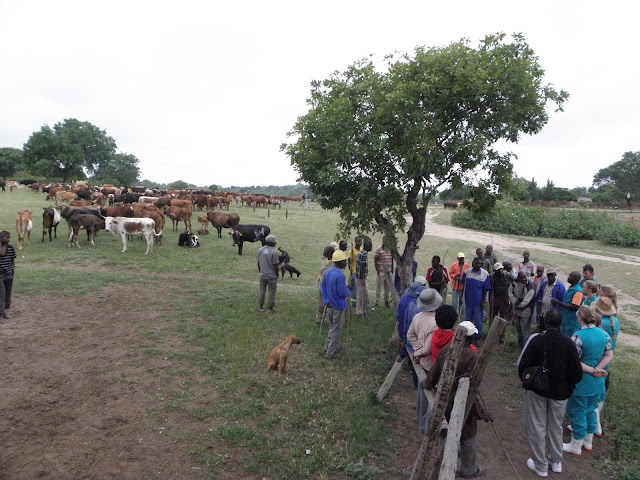By Alysha Aziz
Once again, we got on the road bright and early today as usual behind the trusty Toyota with our facilitator and guide Thembi at the wheel. Today we'll visit two clinics in the deep rural area—Gottenburg clinic and Hluvukani clinic.
Much of our group had visited rural clinics in the past and could outline the
usual challenges, but as the youngest member of the group, I lacked this
experience and was unsure what to expect.
As we drove
up to the Gottenburg clinic, the faded brick building looked decent (if a bit
worn down) from the outside, and a water tower directly in front of the clinic
seemed promising. However, as we walked into the clinic, those illusions were
quickly erased. Due to poor fencing, the grounds of the clinic was home to
several lethargic dogs, who lay sprawled out in the shade just a few feet away
from the doorstep of the waiting area. A few rogue chickens pecked around the
perimeter of the grounds. The clinic was also housed in a relatively small
building, making it difficult for us to walk comfortably in-between waiting
patients and sisters at work.
I was also
surprised, perhaps naively, to learn that the clinic employed only nurses-- no
doctors. A doctor only came for one day every month, leaving the brunt of the
local work with the sisters. This work was exceedingly hard, considering that
the clinic regularly had to grapple with a heavy burden of chronic and
infectious disease among a severely under-privileged population. We learned
that drug stock-outs were not uncommon, and the staff felt as if the clinic was
understaffed for the population they served.
However,
the limitation that I found most striking in Gottenburg was the lack of running
water. We learned that the water tower that had looked so promising outside did
not, in fact, have a working pipe connected to the clinic. This made it very
difficult for the staff to maintain a sterile environment, and safely perform
tasks even as basic as dressing a wound. “See, I just saw a patient and I
didn’t even wash my hands,” said one of the sisters, laughing darkly as if to
say, “what else can I do?” Other nurses showed us how they collected water from
a nearby pump in big plastic buckets.
Hluvukani
clinic similarly operated without running water, despite also having a water
tower in the back. Heartbreakingly enough, we could even see the severed pipe
that theoretically connected the water source to the clinic. We were told that
water was delivered from the municipality and kept in a large storage container—
which struck me as much less cost-effective (and practical) than repairing the
pipe.
Hluvukani
clinic was also far more cramped that Gottenburg, and between the peeling
paint, dingy curtains, and exposed wires on the outside walls, I was
unsurprised to learn that Hluvukani was a relic of apartheid’s homeland health
system. We had heard good news of an opening ceremony for a new clinic next
door, but ironically, its doors of this clinic were still barred because the
electric system was faulty. While the ribbon was cut, no patients were allowed
inside.
At the end
of the day, I felt sobered by the limitations faced by these clinics,
especially given the importance of their work. After all, these clinics
provided treatment and counseling for the most common diseases in the area
(major ones being HIV, tuberculosis, malaria, hypertension and diabetes),
gynecological services and family planning, and critical education on matters
like STI prevention, water purification, and preparation of rehydration
therapy. In addition, they are often the most accessible medical service for
the population they serve. For example, Gottenburg clinic is a full 60 km away
from the nearest hospital. Therefore, it is all the more urgent that they be
adequately maintained and efficiently run.
I was also struck by the way in which the
appearances of these clinics sometimes contradicted reality—water towers
outside, but dry faucets inside—ribbon cutting ceremonies, yet locked doors.
These contradictions could easily lead a passer-by (or provincial government
officer) to believe that everything was running smoothly, if he/she did not
explore further.
Later that
day, when we had the opportunity to sit down and discuss hospital systems with
several members of the Tintswalo hospital management, we asked about the role
that Tintswalo played in supporting these clinics. The staff admitted that they
would like to support the clinics more significantly (as they did in the past
when Bushbuckridge was under the governance of Limpopo province), but were
unable to. After all, the hospitals face their own challenges, such as a
shortage of doctors, and a network of bureaucracy that makes appointing a
doctor a logistical nightmare.
However,
while seeing the structural challenges faced by clinics and hospitals was
sobering, it was also very humbling to meet the people who struggled with these
challenges every day. After seeing everything and exhausting all of our
questions, we would ask the final question, “so why do you stay?” and the
answer was never less than inspiring.
Below are some of the photos taken at the clinics.
 |
| Patient rights |
 |
| Triage and observation table |
 |
| Stores |
 |
| Consultation room |
 |
Field trippers arriving at Hluvukani
The clinic was donated by a local businessman |
 |
| Register keeping is an important part of the job |


















































